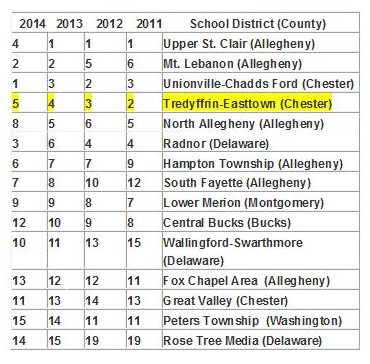 Spring is PSSA time for public schools in Pennsylvania and the results for 2014 as reported in the Pittsburgh Business Times reveal exciting news for Unionville Chadds Ford School District (UCFSD). For those interested in this type of school district rankings, UCFSD now tops the state’s list, having ousted long-standing Upper St. Clair School District for the number one position based on 2014 PSSA results. The Upper St. Clair School District located in suburban Pittsburgh, had previously held the first place title for the last eight years but dropped to fourth in the rankings behind UCFSD, Mt. Lebanon (Allegheny County) and Radnor school districts for 2014.
Spring is PSSA time for public schools in Pennsylvania and the results for 2014 as reported in the Pittsburgh Business Times reveal exciting news for Unionville Chadds Ford School District (UCFSD). For those interested in this type of school district rankings, UCFSD now tops the state’s list, having ousted long-standing Upper St. Clair School District for the number one position based on 2014 PSSA results. The Upper St. Clair School District located in suburban Pittsburgh, had previously held the first place title for the last eight years but dropped to fourth in the rankings behind UCFSD, Mt. Lebanon (Allegheny County) and Radnor school districts for 2014.
The Pennsylvania System of School Assessment (PSSA) formula ranks the school districts based on three years of state standardized test scores, giving the most weight to the current year. The PSSA is a standards-based assessment of what a student should know and be able to do at varying levels in reading, writing, science and math. Reading and math is assessed in grades 3 through 8 and grade 11; writing is assessed in grades 5, 8 and 11 and science assessed in grades 4, 8 and 11. The rankings do not denote the overall quality and performance of the school district, only the PSSA scores.
Although the 2014 rankings show Upper St. Clair School District dropping to fourth place, another Allegheny County school district, Mt. Lebanon holds at second place. This is the fourth consecutive year that I have tracked the top 15 school districts and the highlighted line in the chart below indicates that T/E School District has moved from second in 2011, third in 2012, fourth in 2013 and to fifth place in the 2014 PSSA rankings. Last year we saw UCFSD drop from second in 2012 to third in 2013. However, UCFSD turned it around for 2014 and ended up first in the rankings. Looking at other Main Line school districts, Radnor had dropped from fourth to sixth in 2013 but they also changed direction and are now third in the state. Great Valley School District jumped a couple of spots this year and for 2014, their PSSA scores have them ranked at 11th in the state.
Looking at the ‘Top 15’ school districts in Pennsylvania (based on PSSA results), Allegheny County continues as the number one county with six school districts represented followed by Chester County with three school districts (Unionville Chadds Ford, Great Valley and T/E), Delaware County with three school districts (Radnor, Wallingford Swarthmore and Rose Tree Media) and Montgomery County with one school district (Lower Merion).
A review of other area school districts indicates that Downingtown School District continues to improve; moving from 25th ranking in 2012 to 24th in 2013 and places at 22nd in 2014. Phoenixville School District moved up four positions this year from 98 in 2013 to 94 in 2014.
A Pennsylvania school district that places in the top 15 or 20 out of 500 districts statewide based on the PSSA exams is an achievement for which students, parents, teachers and administrators can all be proud. Many view PSSA scores as a reliable predictor of future success. As a tool for student assessment, the PSSA exam helps measure and provides useful information of what students are learning. The PSSAs measure the performance of the entire class and provide of measurement of how an overall class is performing.
Pennsylvania allows parents to exempt their children from standardized tests for religious reasons. Some elected officials, including State Sen. Andy Dinniman, have been publicly wary of the way standardized tests are used. As Minority Chair of the Senate Education Committee, he offers ‘Eight Reasons Why We Oppose Keystone Graduation Exams’, believing that it is fundamentally wrong for three standardized tests to determine a student’s high school graduation.
Beyond bragging rights for a school district or as a sales tool for local real estate agents, how important are these test results? Do children (and teachers) need this level of pressure to ‘measure up’?

 The fact is that
The fact is that